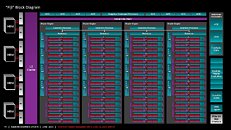Wednesday, May 3rd 2017

AMD "Vega 10" Bears Core-Config Similarities to "Fiji"
A Linux patch for AMD's GPU drivers reveals that its upcoming "Vega 10" graphics processor bears numeric core-configuration similarities to the "Fiji" silicon which drives the enthusiast-segment Radeon R9 Fury series graphics cards. The patch bears configuration values which tell the software how to utilize the resources on the GPU, by spelling them out. The entry "gfx.config.max_shader_engines = 4," for example, indicates that "Vega 10" features four shader engines, like "Fiji." Another entry "Adev-> gfx.config.max_cu_per_sh = 16" signifies the number of GCN compute units (CUs) per shader engine. Assuming the number of stream processors per CU hasn't changed from 64 in the "Vega" architecture, we're looking at a total stream processor count of 4,096. This could also put the TMU count at 256.
At earlier reveals of the "Vega 10" package, you notice a large, somewhat square GPU die neighboring two smaller rectangular memory stack dies, which together sit on a shiny structure, which is the silicon interposer. The presence of just two memory stack dies sparked speculation that "Vega 10" features a narrower 2048-bit memory interface compared to the 4096-bit of "Fiji," but since the memory itself is newer-generation HBM2, which ticks at higher clocks, AMD could run them at double the memory clock as "Fiji" to arrive at the same 512 GB/s bandwidth. The 4,096 stream processors of "Vega 10" are two generations ahead of the ones on "Fiji," which together with 14 nm process-level improvements, could run at much higher GPU clocks, making AMD get back into the high-end graphics segment.
Sources:
aceCrasher (Reddit), ComputerBase.de
At earlier reveals of the "Vega 10" package, you notice a large, somewhat square GPU die neighboring two smaller rectangular memory stack dies, which together sit on a shiny structure, which is the silicon interposer. The presence of just two memory stack dies sparked speculation that "Vega 10" features a narrower 2048-bit memory interface compared to the 4096-bit of "Fiji," but since the memory itself is newer-generation HBM2, which ticks at higher clocks, AMD could run them at double the memory clock as "Fiji" to arrive at the same 512 GB/s bandwidth. The 4,096 stream processors of "Vega 10" are two generations ahead of the ones on "Fiji," which together with 14 nm process-level improvements, could run at much higher GPU clocks, making AMD get back into the high-end graphics segment.

63 Comments on AMD "Vega 10" Bears Core-Config Similarities to "Fiji"
www.nvidia.com/en-us/geforce/products/10series/titan-xp/
Go there and click on "Specs" then "Full Specs", it's right there, in reverse black and white. 11.4Gbps on a 384-bit wide bus, equals 547.7GB/s
That's about the same absurd as saying Volkswagen Polo with 1.0 engine is the same as Mitsubishi Lancer Evo X with a 2.0 Turbo engine, just because they both have 4 cylinders.
EDIT: Fixed from Volkswagen Up! to Polo because some people were annoyed :P
Conservative numbers put Vega as double the 480's stats with at least 20% higher IPC (Or a lot more if tiled rendering pans out for AMD like it did for Maxwell). They just better be able to clock it high enough by June!
www.tweaktown.com/news/57323/radeon-rx-vega-barely-beats-gtx-1070-leaked-results/index.html
This is based on useless leak Guru3D posted before...
I think the most critical thing is how will AMD address the utilization of wide highway of shaders for lower resolutions. The new scheduler could address this, but isn't necessary. This is one of things that are unknowns and it's quite possible I won't be able to buy RX Vega because of this. If AMD will just rely on fact that most demanding users use 4K anyway, this makes RX Vega less desirable for me where I demand high framerate at 1080p to fully utilize 144Hz monitor. Meaning, if outcome is similar to R9 Fury X, it's likely I'll be forced to wait for Volta. I know, it's a rather rare specific thing, but still.
Won't be long now till we can read reviews from random sources if TPU isn't getting one.
But let's see where Vega lands :P
One big positive I can extract from this is the focus on higher clocks. I really hope they land at 1500 stock, that could put Vega in a pretty good place.
Don't worry, they'll praise nvidia for using it and say how it's so good when nvidia finally brings it to the consumer level.
Not until the GPU itself gets a lot faster.
Synthetic bench lololololol
And we're going to ignore how fury x perf doesn't tank when you GBs over on VRAM usage, eh?
I have yet to see anything but speculation from your side.